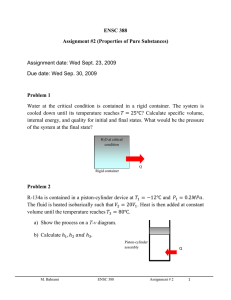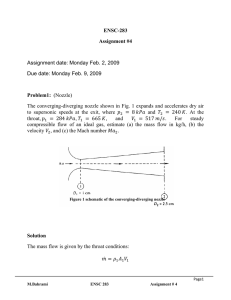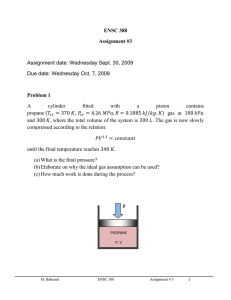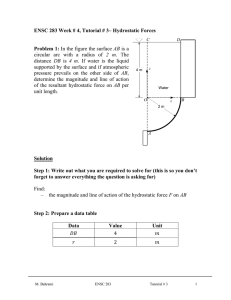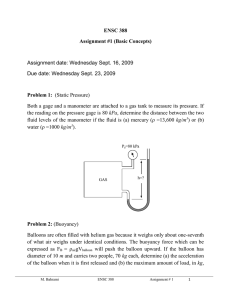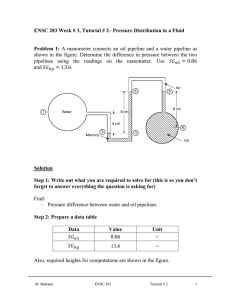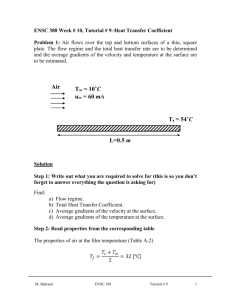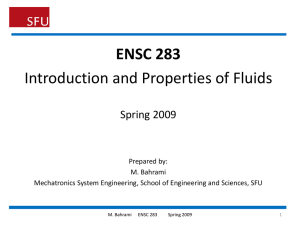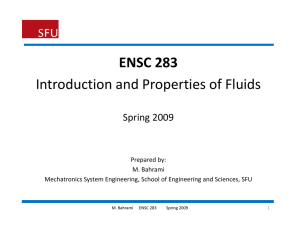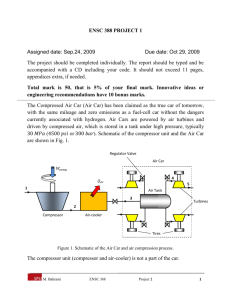Assignment2_Solution
advertisement
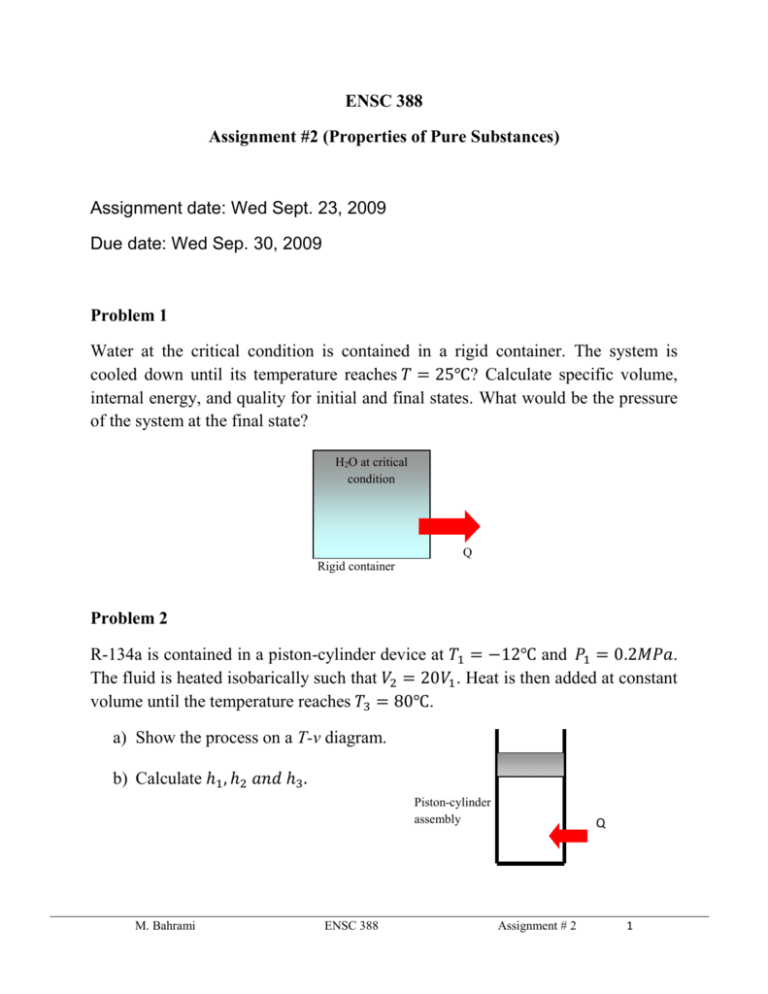
ENSC 388 Assignment #2 (Properties of Pure Substances) Assignment date: Wed Sept. 23, 2009 Due date: Wed Sep. 30, 2009 Problem 1 Water at the critical condition is contained in a rigid container. The system is cooled down until its temperature reaches 𝑇 = 25℃? Calculate specific volume, internal energy, and quality for initial and final states. What would be the pressure of the system at the final state? H2O at critical condition Q Rigid container P1=1 bar Problem 2 R-134a is contained in a piston-cylinder device at 𝑇1 = −12℃ and 𝑃1 = 0.2𝑀𝑃𝑎. The fluid is heated isobarically such that 𝑉2 = 20𝑉1 . Heat is then added at constant volume until the temperature reaches 𝑇3 = 80℃. a) Show the process on a T-v diagram. b) Calculate ℎ1 , ℎ2 𝑎𝑛𝑑 ℎ3 . Piston-cylinder assembly M. Bahrami ENSC 388 Q Assignment # 2 1 Problem 1: Known: 𝑇1 = 𝑇𝑐𝑟 = 373.95℃ 𝑣1 = 𝑣𝑐𝑟 = 0.003106 [ 𝑇2 = 25℃ 𝑚3 𝑘𝑔 ] 𝑣2 = 𝑣1 Find: - Specific volume, internal energy and quality at states 1 and 2. - Pressure at state 2 Assumptions: - Rigid tank - Negligible kinetic and potential energies Analysis: Since the volume of the tank and the mass of water in the container remains constant, the process is a constant specific volume process 𝑣2 = 𝑣1 . This process can be shown as a vertical line in a T-v diagram. T 1 𝑇𝑐𝑟 2 𝑇2 = 25℃ 𝑣2 = 𝑣1 𝑣 T-v Diagram M. Bahrami ENSC 388 Assignment # 2 2 We should first check to see if state 2 is a saturated mixture. Using Table A-4 at 𝑇𝑠𝑎𝑡 = 25℃ : 𝑣𝑓@25℃ 𝑚3 𝑚3 𝑚3 = 0.001003 [ ] < 𝑣2 = 0.003106 [ ] < 𝑣𝑔@25℃ = 43.340 [ ] 𝑘𝑔 𝑘𝑔 𝑘𝑔 Since the specific volume of state 2 falls between that of the saturated liquid and the saturated vapour at 25℃, one can conclude the state 2 is a saturated mixture. 𝑣2 = 𝑣𝑓 + 𝑥2 𝑣𝑓𝑔 From Table A-4: 𝑥2 = 𝑣2 − 𝑣𝑓,2 𝑣𝑔,2 − 𝑣𝑓,2 𝑚3 𝑚3 0.003106 [ ] − 0.001003 [ ] 𝑘𝑔 𝑘𝑔 = → 𝑥2 = 0.0000485 3 𝑚 𝑚3 43.340 [ ] − 0.001003 [ ] 𝑘𝑔 𝑘𝑔 𝑘𝐽 𝑘𝐽 𝑘𝐽 𝑢2 = 𝑢𝑓,2 + 𝑥2 𝑢𝑓𝑔,2 = 104.83 [ ] + 0.0000485 × 2304.3 [ ] = 104.94 [ ] 𝑘𝑔 𝑘𝑔 𝑘𝑔 𝑘𝐽 𝑢1 = 𝑢𝑐𝑟 = 2015.7 [ ] 𝑘𝑔 Since state 2 is a saturated mixture from Table A-4: 𝑃2 = 𝑃𝑠𝑎𝑡@25℃ = 3.1698[𝑘𝑃𝑎] M. Bahrami ENSC 388 Assignment # 2 3 Problem 2: Known: 𝑃1 = 0.2𝑀𝑃𝑎 𝑇1 = −12℃ 𝑃2 = 𝑃1 𝑉2 = 20𝑉1 𝑉3 = 𝑉2 𝑇3 = 80℃ Find: ℎ1 , ℎ2 & ℎ3 Assumptions: - Saturated liquid properties for compressed liquid state considered, except for property h. Analysis: Let’s starting with properties of the system at states 1, 2 and 3: 3 𝑘𝐽 State 𝑇[℃] 𝑃[𝑘𝑃𝑎] 𝑣 [𝑚 ⁄𝑘𝑔] ℎ [ ⁄𝑘𝑔] 1 −12 200 𝑣1 ℎ1 2 𝑇2 3 80 𝑃2 = 𝑃1 𝑣2 = 20𝑣1 𝑃3 𝑣3 = 𝑣2 ℎ2 ℎ3 State 1: With 𝑇1 = −12℃ → 𝑃𝑠𝑎𝑡 = 185.37[𝑘𝑃𝑎] = 0.185[𝑀𝑃𝑎] (Table A-11) Since (𝑃1 > 𝑃𝑠𝑎𝑡,1 ), state 1 is compressed liquid. Because we do not have a compressed liquid Table for R-134a, it is assumed: M. Bahrami ENSC 388 Assignment # 2 4 𝑣1 ≈ 𝑣𝑓,1@−12℃ 𝑚3 = 0.0007499 [ ] 𝑘𝑔 ℎ1 = ℎ𝑓,1 + 𝑣𝑓,1 (𝑃1 − 𝑃𝑠𝑎𝑡@−12℃ ) Using Table A-11: 𝑘𝐽 𝑚3 𝑘𝑁 𝑘𝐽 ℎ1 = 35.92 [ ] + 0.0007499 [ ] (200 − 185.37) [ 2 ] = 35.93 [ ] 𝑘𝑔 𝑘𝑔 𝑚 𝑘𝑔 𝑘𝐽 State 𝑇[℃] 𝑃[𝑘𝑃𝑎] 𝑣 [𝑚 ⁄𝑘𝑔] ℎ [ ⁄𝑘𝑔] 3 1 −12 200 0.0007499 35.93 2 𝑇2 200 0.015 ℎ2 3 80 𝑃3 0.015 ℎ3 State 2: 𝑚3 𝑣2 = 20𝑣1 = 0.015 [ ] 𝑘𝑔 From Table A-12 at 𝑃2 = 200𝑘𝑃𝑎: 𝑣𝑓,2 𝑚3 𝑚3 𝑚3 = 0.0007533 [ ] < 𝑣2 = 0.015 [ ] < 𝑣𝑔,2 = 0.099867 [ ] 𝑘𝑔 𝑘𝑔 𝑘𝑔 The quality of the mixture can be found: 𝑥2 = M. Bahrami 𝑣2 − 𝑣𝑓,2 𝑣𝑔,2 − 𝑣𝑓,2 𝑚3 𝑚3 0.015 [ ] − 0.0007533 [ ] 𝑘𝑔 𝑘𝑔 = = 0.144 3 𝑚 𝑚3 0.099867 [ ] − 0.0007533 [ ] 𝑘𝑔 𝑘𝑔 ENSC 388 Assignment # 2 5 Therefore: ℎ2 = (1 − 𝑥)ℎ𝑓 + 𝑥ℎ𝑔 ℎ2 = (1 − 0.144) × 38.43 [ 𝑘𝐽 𝑘𝐽 𝑘𝐽 ] + 0.144 × 244.46 [ ] = 68.1 [ ] 𝑘𝑔 𝑘𝑔 𝑘𝑔 3 State 𝑇[℃] 𝑃[𝑘𝑃𝑎] 𝑣 [𝑚 ⁄𝑘𝑔] ℎ [𝑘𝐽⁄𝑘𝑔] 1 −12 200 0.0007499 35.93 2 10.09 200 0.015 68.1 3 80 𝑃3 0.015 ℎ3 State 3: During process 2-3, the volume and the mass of the system remain constant; therefore it is a constant specific volume process, i.e.: 𝑚3 𝑣3 = 𝑣2 = 0.015 [ ] 𝑘𝑔 A constant specific volume process can be shown as a vertical line in a T-v diagram. Using saturated Table A-11 at 𝑇3 = 80℃: 𝑚3 𝑚3 𝑣𝑔 = 0.006436 [ ] < 𝑣3 = 0.015 [ ] 𝑘𝑔 𝑘𝑔 Thus state 3 is superheated vapour and Table A-13 should be used. Looking for the range of 𝑣3 in Table A-13 one can find: 1.4[𝑀𝑃𝑎] < 𝑃3 < 1.6[𝑀𝑃𝑎] M. Bahrami ENSC 388 Assignment # 2 6 where 𝑣@1.4𝑀𝑃𝑎 𝑚3 = 0.017023 [ ] 𝑘𝑔 𝜗@1.6𝑀𝑃𝑎 𝑚3 = 0.014362 [ ] 𝑘𝑔 Interpolating for ℎ3 : ℎ3 − ℎ@1.4𝑀𝑃𝑎 𝑣3 − 𝑣@1.4𝑀𝑃𝑎 = ℎ@1.6𝑀𝑃𝑎 − ℎ@1.4𝑀𝑃𝑎 𝑣@1.6𝑀𝑃𝑎 − 𝑣@1.4𝑀𝑃𝑎 𝑘𝐽 𝑚3 𝑚3 ℎ3 − 308.34 [ ] 0.015 [ ] − 0.017023 [ ] 𝑘𝑔 𝑘𝑔 𝑘𝑔 = 3 𝑘𝐽 𝑘𝐽 𝑚 𝑚3 305.07 [ ] − 308.34 [ ] 0.014362 [ ] − 0.017023 [ ] 𝑘𝑔 𝑘𝑔 𝑘𝑔 𝑘𝑔 𝑘𝐽 → ℎ3 = 305.85 [ ] 𝑘𝑔 3 State 𝑇[℃] 𝑃[𝑘𝑃𝑎] 𝑣 [𝑚 ⁄𝑘𝑔] ℎ [𝑘𝐽⁄𝑘𝑔] M. Bahrami 1 −12 200 0.0007499 35.93 2 10.09 200 0.015 68.1 3 80 1447.8 0.015 305.85 ENSC 388 Assignment # 2 7 The properties of the three states are: state 1, compressed liquid, state 2, saturated mixture and state 3, superheated vapour. Thus the T-v diagram can be plotted as Fig. 1. T 𝑃3 3 80℃ 𝑃2 = 𝑃1 −10.09℃ −12℃ 2 1 𝑣2 = 𝑣3 𝑣 Fig.1. T-v diagram of the process Note: In the absence of compressed liquid data, a general approximation is to treat compressed liquid as saturated liquid at the given temperature. However, the error in h at low to moderate pressures and temperatures can be reduced significantly by evaluating it from: ℎ ≅ ℎ𝑓@𝑇 + 𝑣𝑓@𝑇 (𝑃 − 𝑃𝑠𝑎𝑡@𝑇 ) M. Bahrami ENSC 388 Assignment # 2 8
